Sensar Marine Boat + Bilge Monitor: elegant monitoring simplified
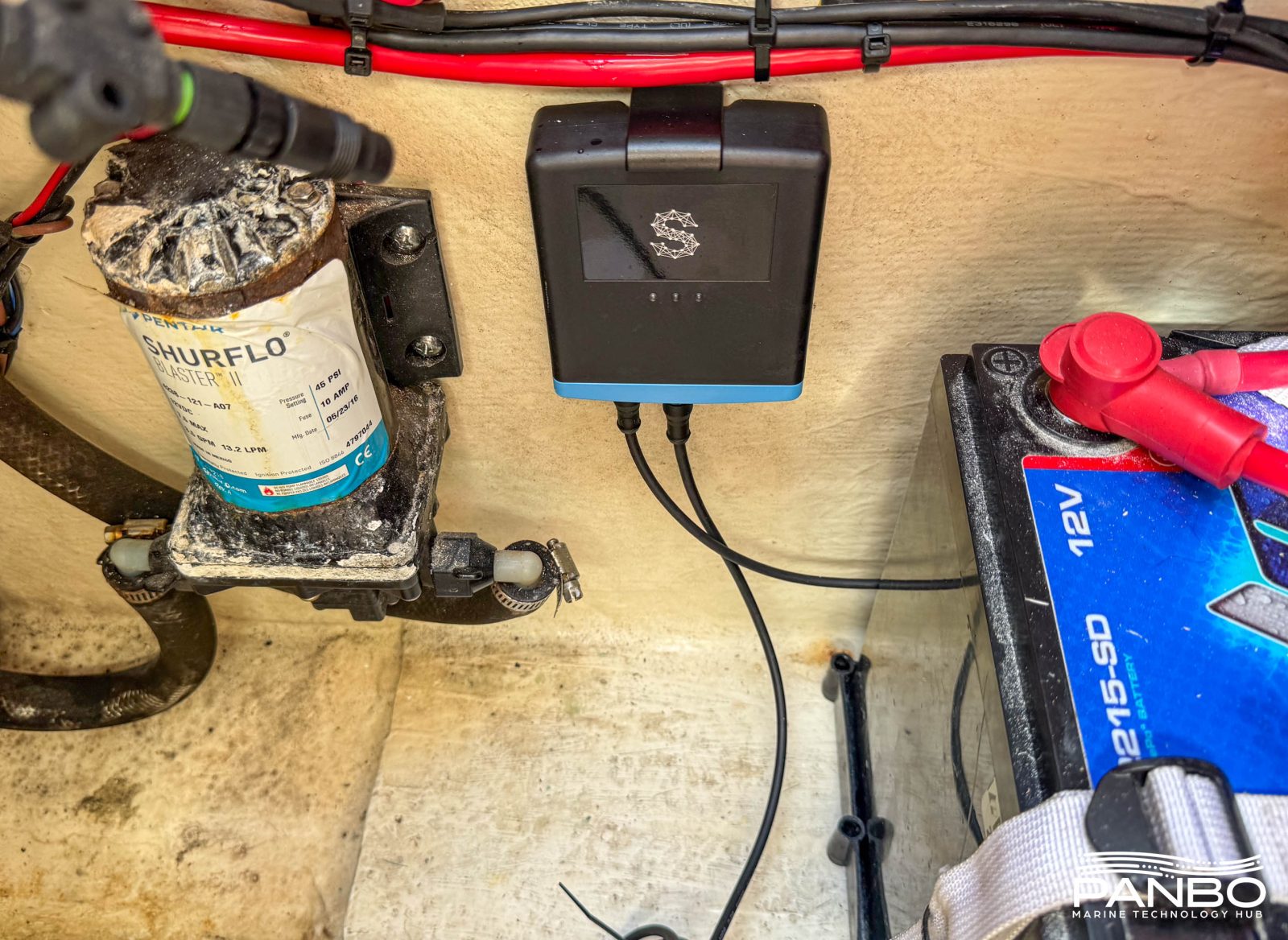
In my mind, boat monitors fall into one of two categories: high-end systems that can do everything and simple systems focused on key systems. The former category typically includes all manner of sensors, network interfaces, and other options. Monitors in the latter category focus on monitoring critical indicators of a boat’s health. Depending on the size, complexity, and use of a boat, there are scenarios that fit both categories. Sensar Marine’s Boat and Bilge Monitor focuses on critical systems and may be the most refined example I’ve tested. Overall, I was pleased with how the monitor worked while seeing a few opportunities for even better performance.
The hardware
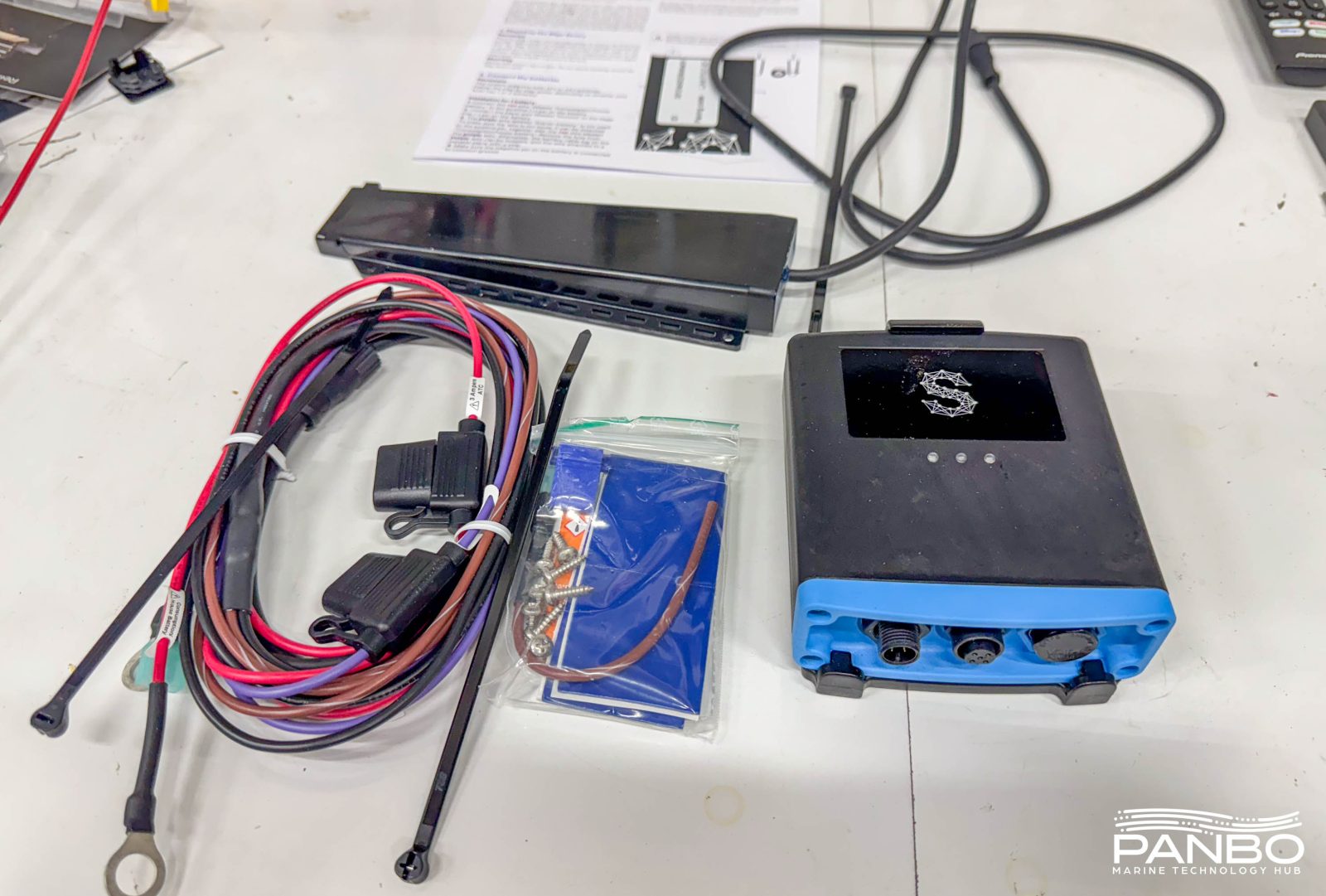
Sensar Marine offers one product: their Boat Monitor with Bilge Sentry. The $500 package includes two components: the monitor itself and the Bilge Sentry. The monitor is a dense, plastic-cased box of roughly four inches by four inches. There’s a large battery built into the case that can power the system for up to 40 days with no external power. The Bilge Sentry is a solid-state water level and both air and water temperature sensors designed for vertical mounting in the bilge. Sensar includes enough double-sided tape to allow mounting both components with just tape. The monitor includes a small plastic holster that mounts first before the unit snaps in place.
The monitor itself contains a GPS receiver, 4G cellular radio, shock sensor, and three status LEDs. Both the monitor and Bilge Sentry carry IPx7 meaning they can be submerged for up to 30 minutes at 1 meter. Sensar says the system is aimed at boats 15 to 35 feet. They stand behind the monitor and Bilge Sentry with a five year warranty.

The last piece of the installation is making the wiring connections. The wiring harness screws to one of the two ports on the bottom of the monitor and the Bilge Sentry screws to the other. The harness has two fused leads for monitoring a house and starter battery, a ground connection, and a connection for monitoring a bilge pump for activation. The bilge pump lead measures voltage when the pump activates. The wire in the harness is tinned marine wire. Additionally, each wire has a clearly legible label threaded onto the wire.
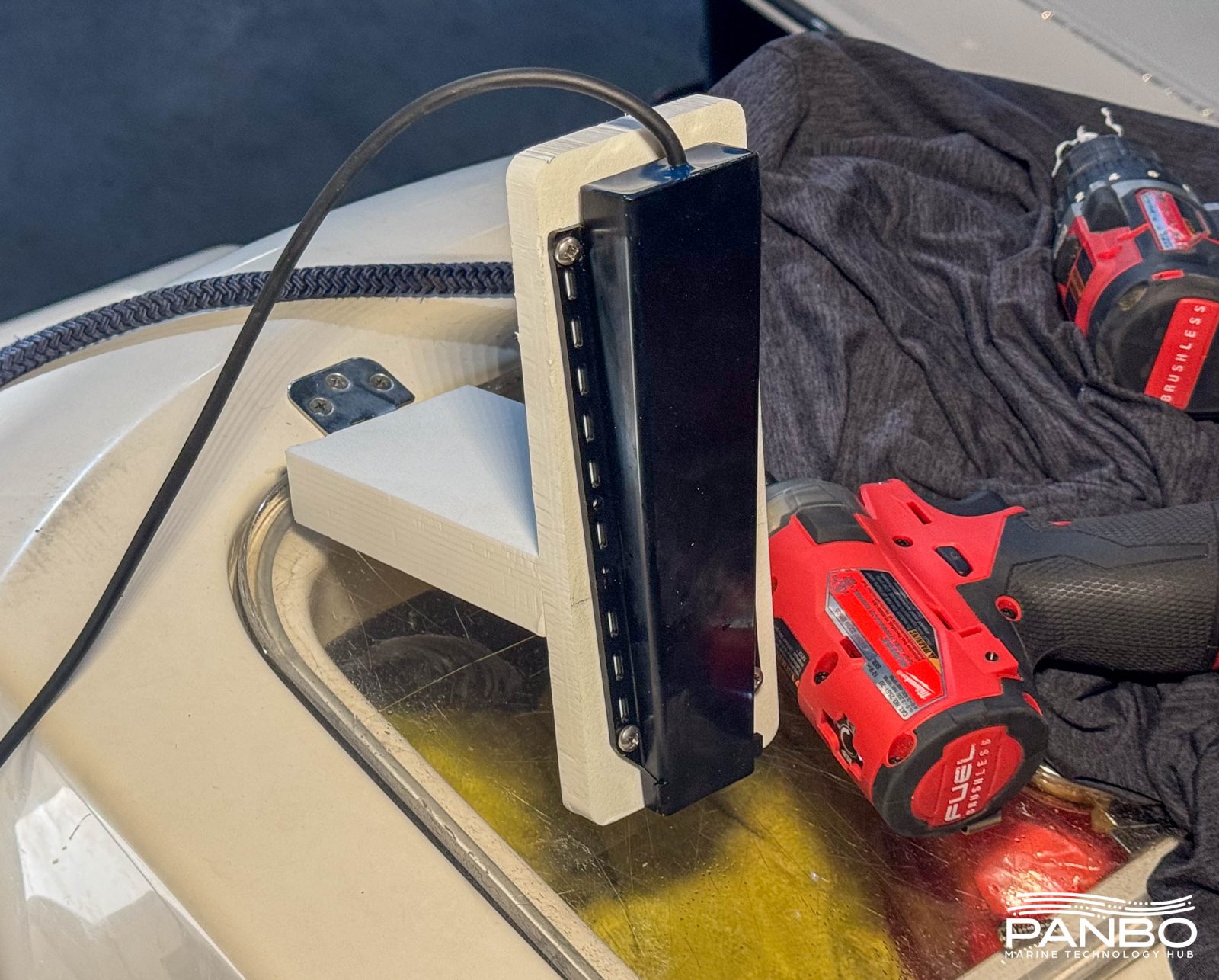
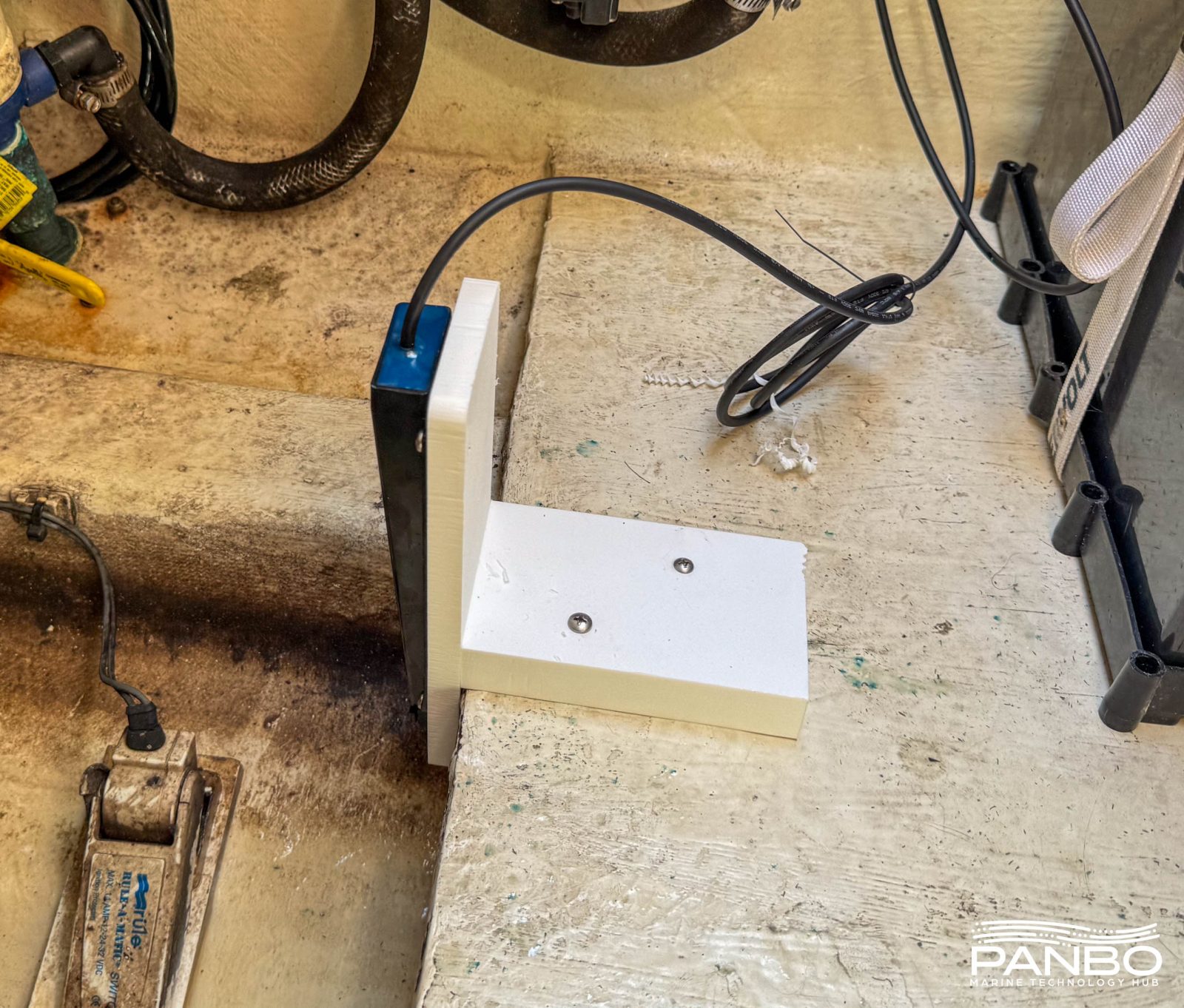
All of the hardware feels solid and well-made. Installation is extremely easy with just four connections and securing the bilge monitor required. The bilge of Panbo(at) doesn’t have a great place to put the Bilge Sentry where it would reach the center of the bilge. So, I ended up making a small bracket out of starboard that I secured to the bilge’s false floor.
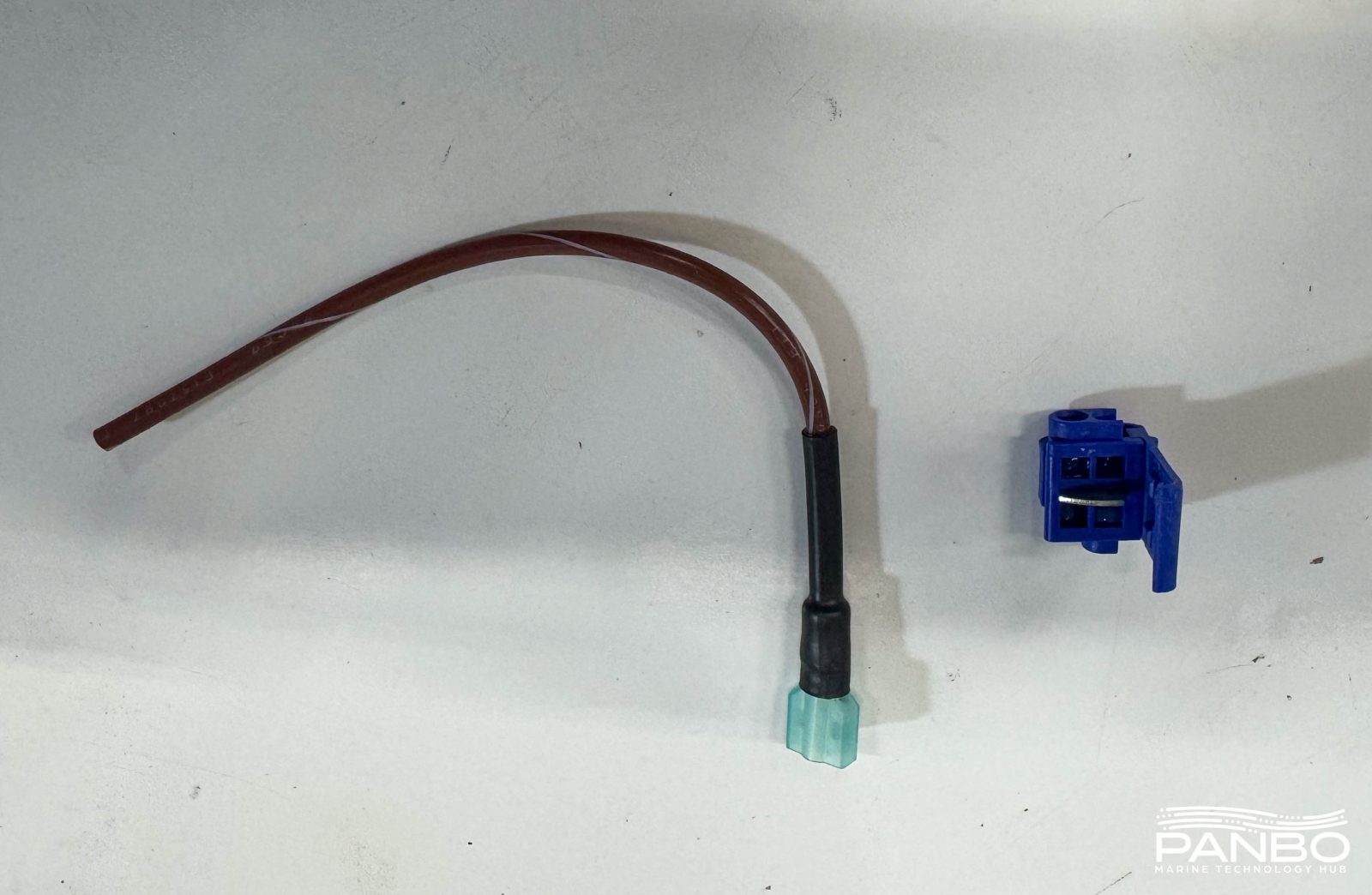
Sensar includes a 3M Scotchlok electrical tap connector and a short pigtail of wire for sensing bilge pump activation. I’m not comfortable with the use of these insulation-piercing connectors on safety systems like bilge pumps, especially in a wet environment like a boat’s bilge. These connectors work by piercing into the insulation and touching the conductor. If the Scothlok doesn’t match the wire size or the installer overcrimps the connector, the wire can easily end up damaged. That damage could result in the bilge pump losing power. Although Sensar calls for using the piercing Scotchlok connector on the manual activation portion of the circuit, I still have concerns about piercing any part of the bilge pump wiring. For my installation, I cut out an existing splice in the bilge pump wiring and spliced in a lead to connect to the monitor’s bilge sense connection using water-tight heat shrink butt connectors.
Subscription options
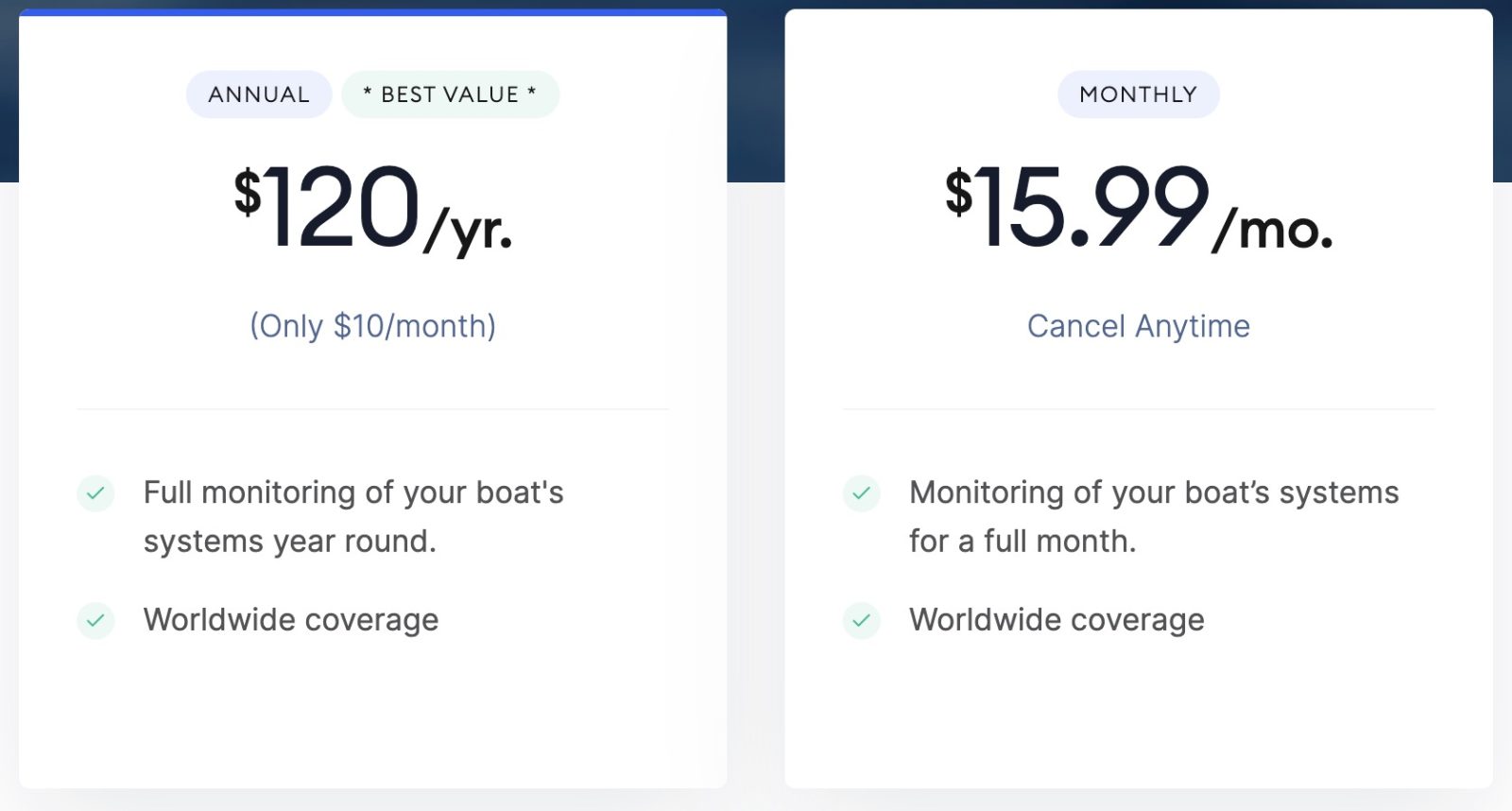
There are only two subscription options. Those options are a $16 per month pay-as-you-go plan or a $120 per year annual option. Both plans offer worldwide coverage when in range of cellular networks. Additionally, there aren’t any notification quotas or update limits mentioned in the plans.
Preinstallation tests
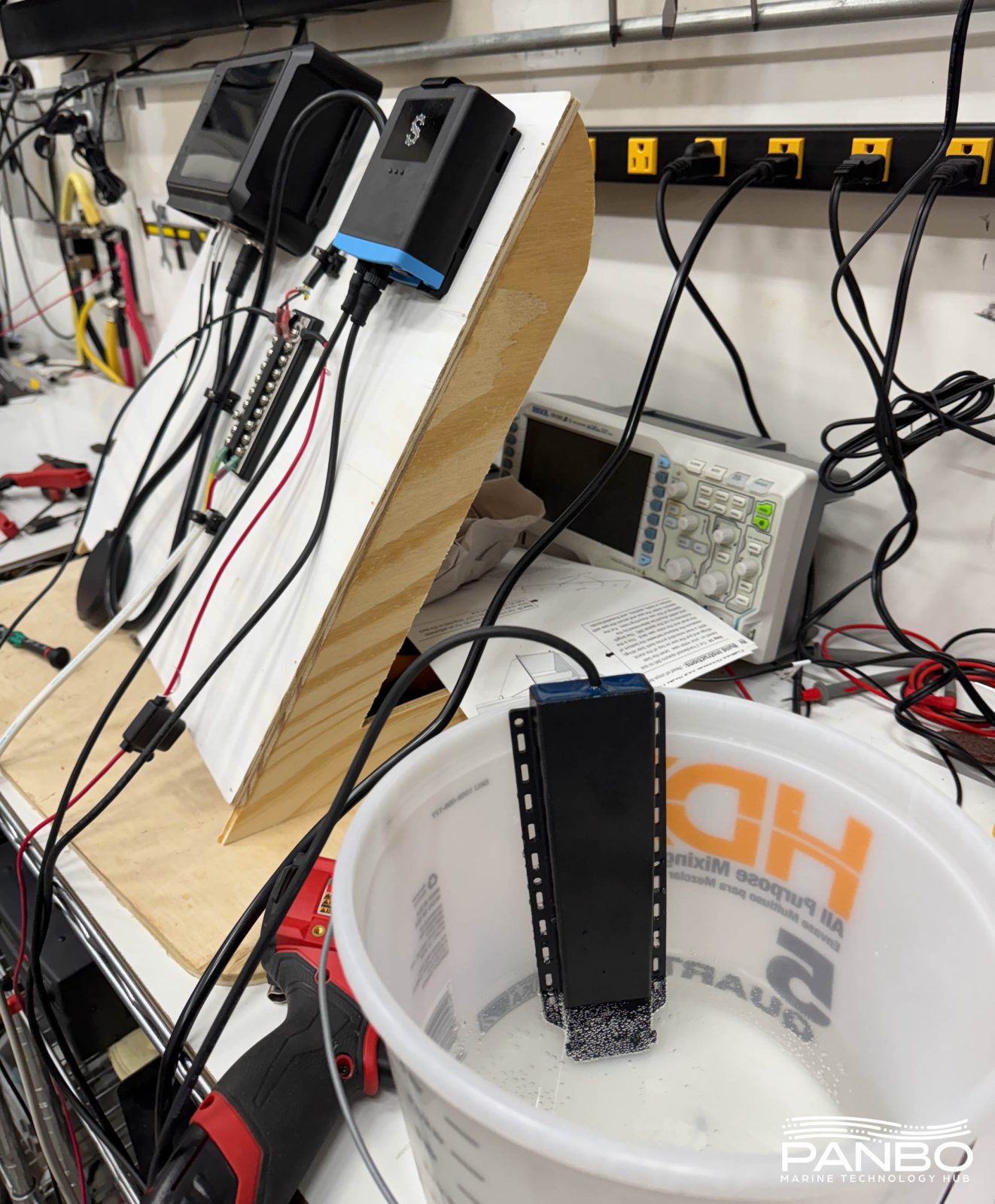
Before I installed the system in Panbo(at) I did a quick bit of verification on my test bench. Each of the functions of the system worked well. Although, not surprisingly location didn’t work until I took the unit outside of my metal roofed building. I also tested the bilge sensor’s depth and temperature capabilities. I found both to be surprisingly accurate. In fact, I was skeptical when the app reported the sensor was in 2.4 inches of water, but a quick verification with a ruler proved that the reading was accurate.
Using the monitor
With my bench testing complete I moved the monitor to Panbo(at) for on-the-water testing. Given the simple four-wire connection, installation only took a few minutes. As soon as I completed the physical installation, the monitor started collecting data.
Battery monitoring
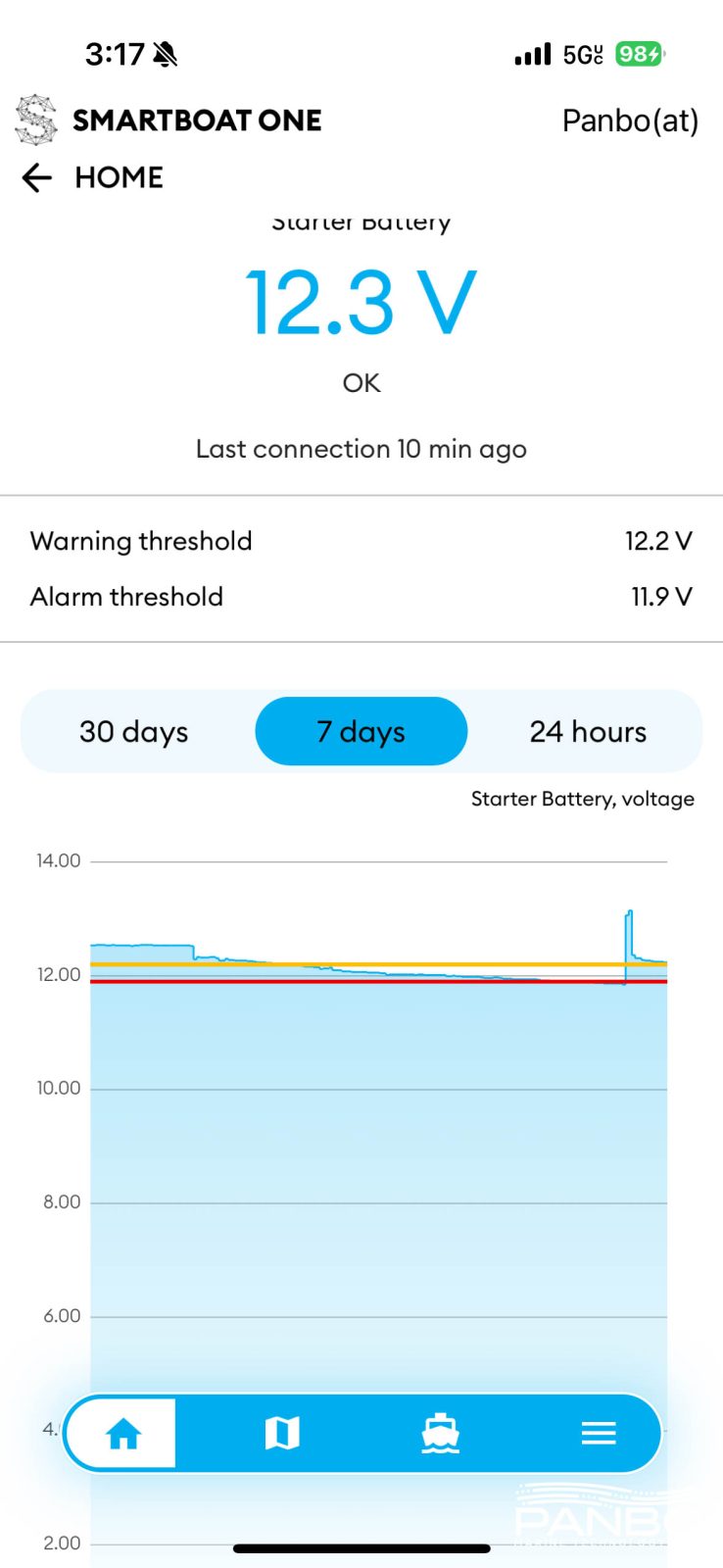
Post Hurricane Ian, Panbo(at) lives at a rack storage facility. So, I had the boat launched to complete the installation. I had to do some other work in the bilge, so I left the bilge pump wiring for another day. Later, the facility put the boat back in the rack. As soon as they did I got a voltage alert for the lead-acid battery. I first called and asked them to double-check that the battery switch was turned off. They verified it was off, but the voltage continued to drop. I headed back to the boat and found a piece of debris — that I left — had wedged itself under the float switch and the bilge pump was running. Score one for Sensar. Even without the bilge pump sense lead connected, it had saved me from at least a dead battery and possibly much worse if the pump overheated.
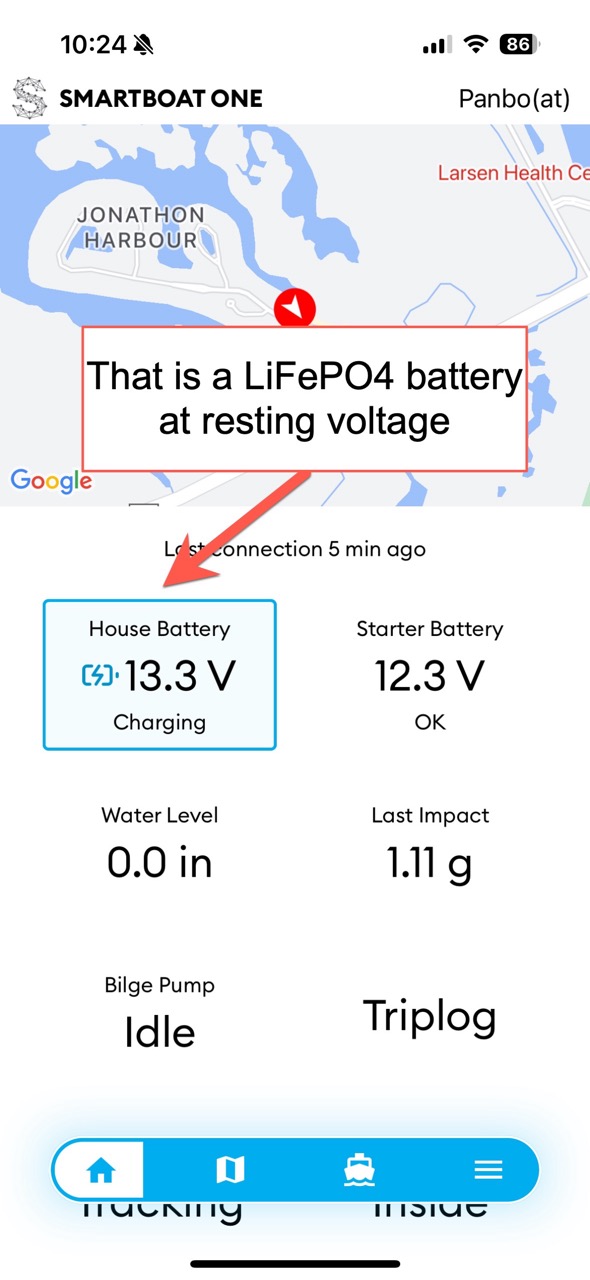
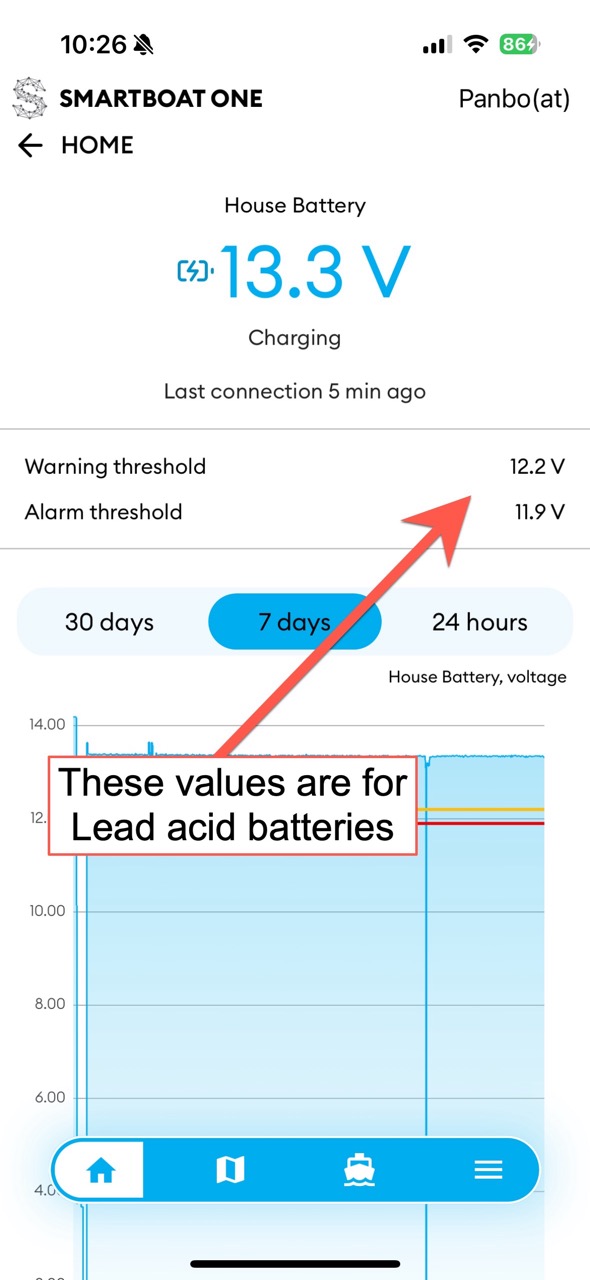
While we’re talking about batteries, let’s cover a current limitation of the system. Sensar assumes all batteries on the boat are lead-acid chemistries and hence have the voltage readings of a lead-acid battery. They use these voltage assumptions to determine the batteries’ charge status. That determination is used both to populate the app’s display and to determine whether the monitor should pull power from the house battery. The idea is, that the monitor only pulls power to run itself and recharge the internal battery during charging.
Panbo(at) has one lead-acid and one LiFePO4 battery. LiFePO4 batteries have a resting voltage of about 13.4 volts. That also happens to be right around the float voltage of lead-acid batteries. As a result, Sensar sees the higher voltage and assumes the battery is being charged, and draws power even when the battery isn’t charging. Fortunately, the system draws very little power and this hasn’t been a problem so far. Additionally, Sensar is working on an update to allow the selection of battery chemistry.
The alert thresholds shown in the screenshot above aren’t configurable. Sensar explains that they believe providing users with too many options leads to misconfigurations and missed alerts. I understand their point and recognize the simplicity it provides. But, I also would like some control over basic parameters like voltage levels. I think they could provide both simplicity and configurability by protecting the settings in the UI.
Bilge pump monitoring
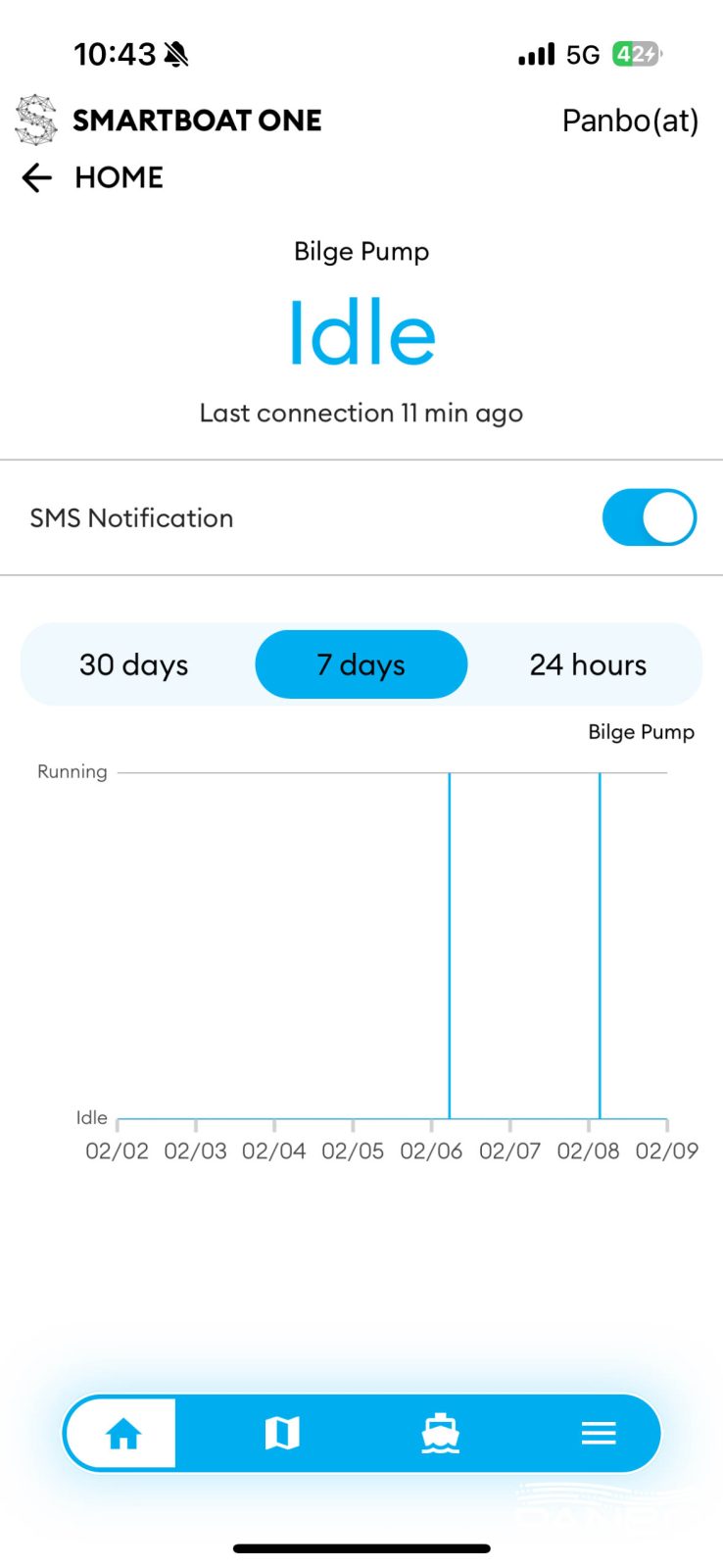

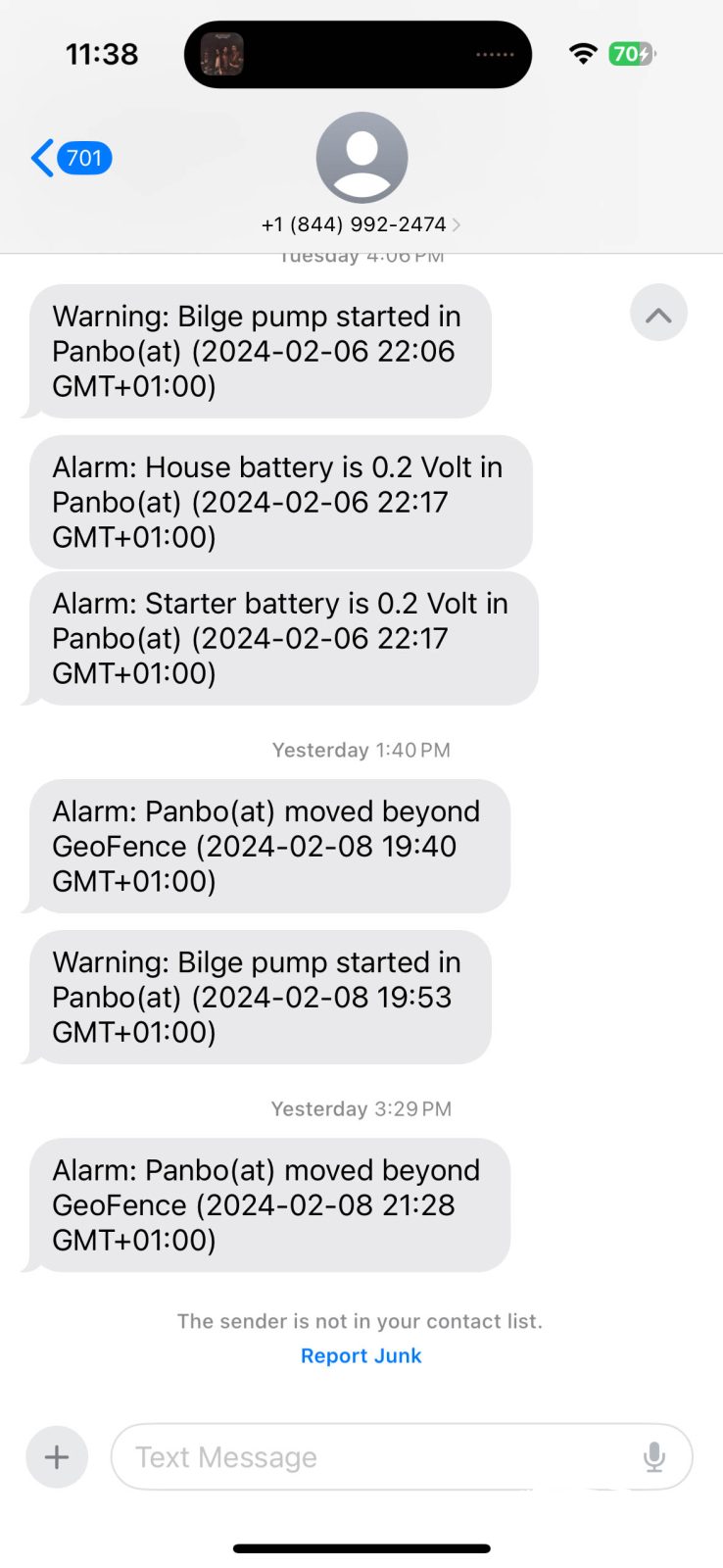
Bilge pump monitoring couldn’t be simpler. Once the sense lead is connected to the monitor, the system will see each time power is applied to the bilge pump. You only have one choice within the bilge monitoring screen and that turns SMS notifications on and off. Once again, Sensar chooses simplicity over configurability. When the SMS notification is turned on, the system will send an SMS alert each time the bilge pump is activated.
Most other monitoring products I’ve reviewed allow alerts based on rules. For example, notify me if the pump runs three or more times in an hour or notify me if the pump runs for more than two minutes. On a wet boat, I can see how Sensar’s approach could become a nuisance. But, on Panbo(at) where the bilge pump very rarely runs (I manually triggered all the alerts above) it’s not likely to be an issue.
Temperature and bilge level
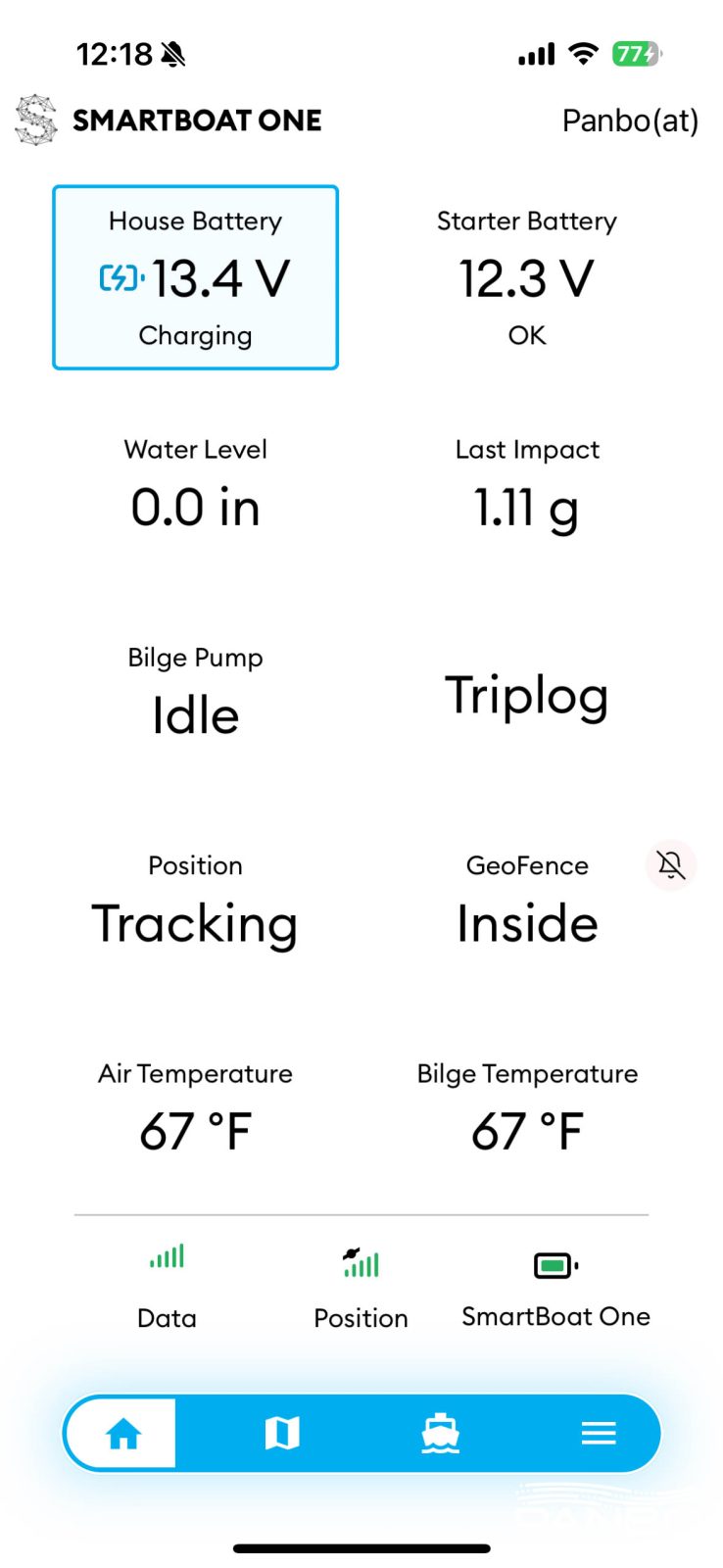
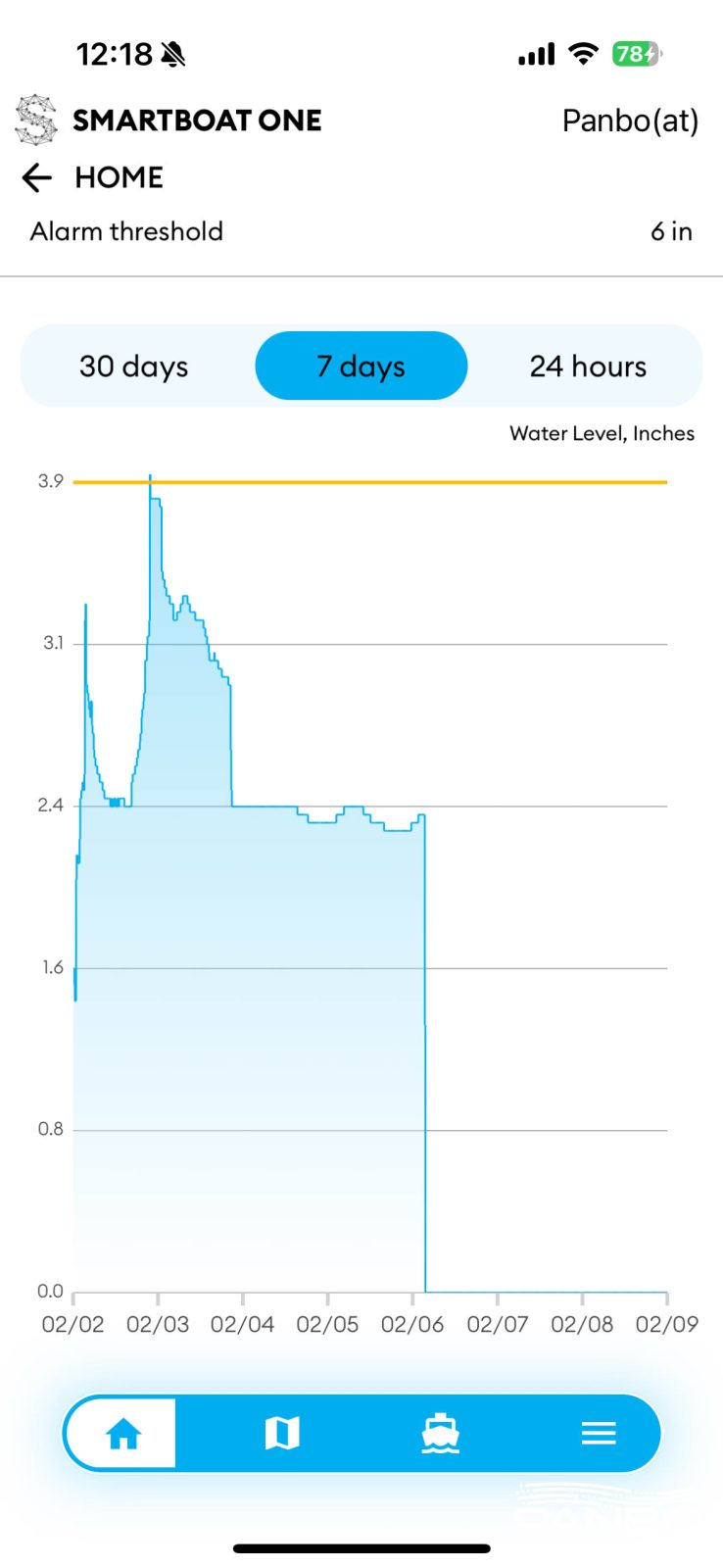
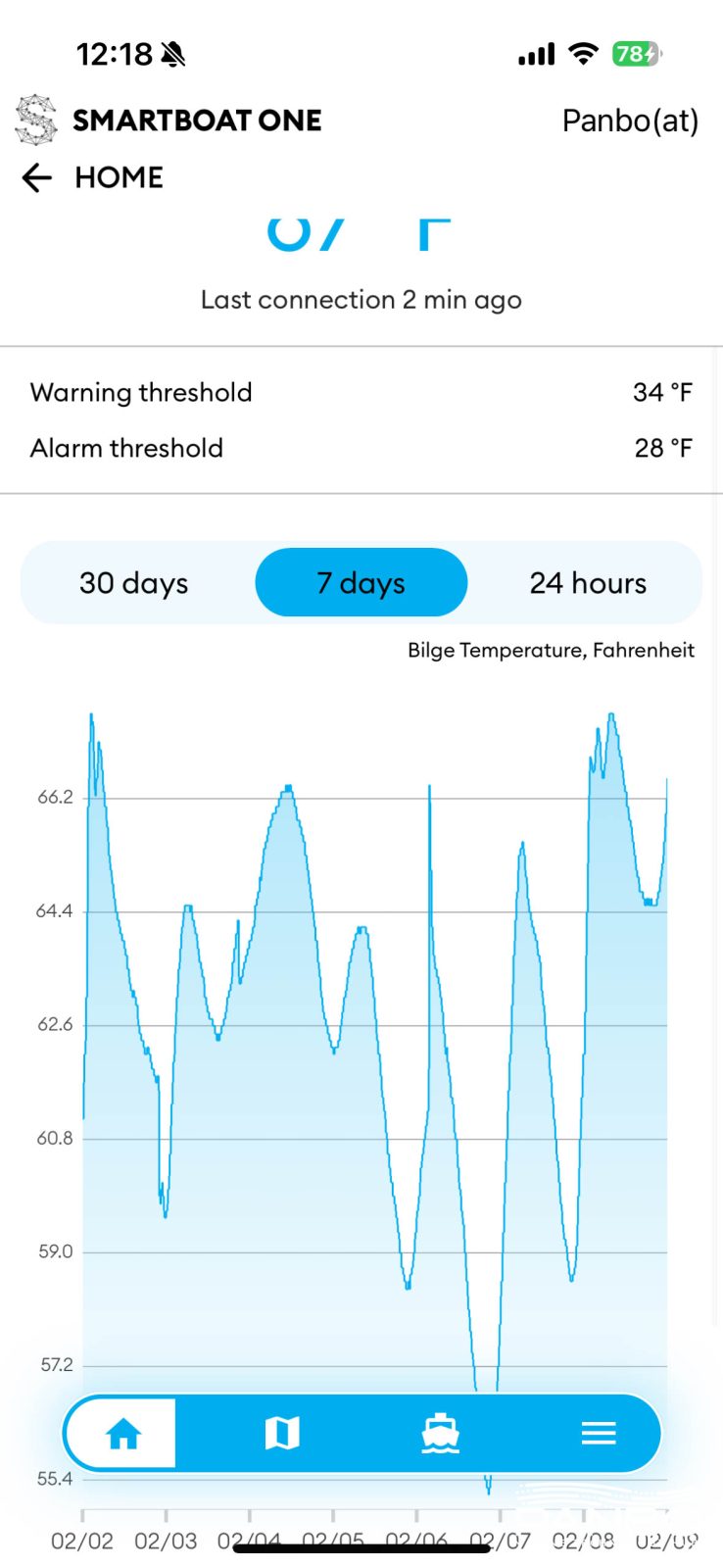
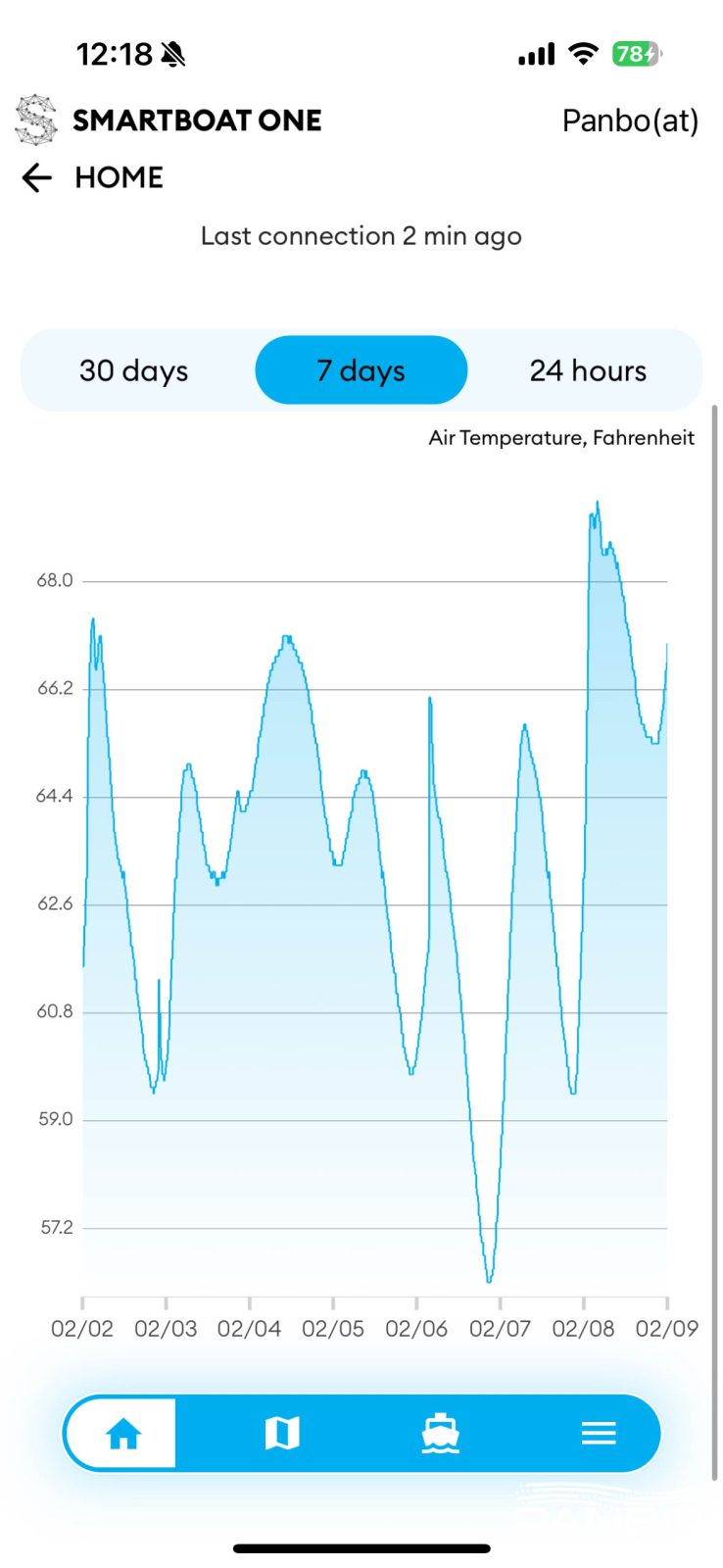
Sensar captures bilge level and temperature via the Bilge Sentry and air temperature via the monitor itself. On Panbo(at), those two temperatures are likely to be the same since the monitor and Bilge Sentry are only a few inches apart. Consistent with their approach, alerts for bilge levels and temperature are both preset. That seems fine to me but I’d like a warning raised before 34 degrees and an alarm before 28 degrees. Fortunately, in southwest Florida, I don’t expect that to become a problem.
Trip logging
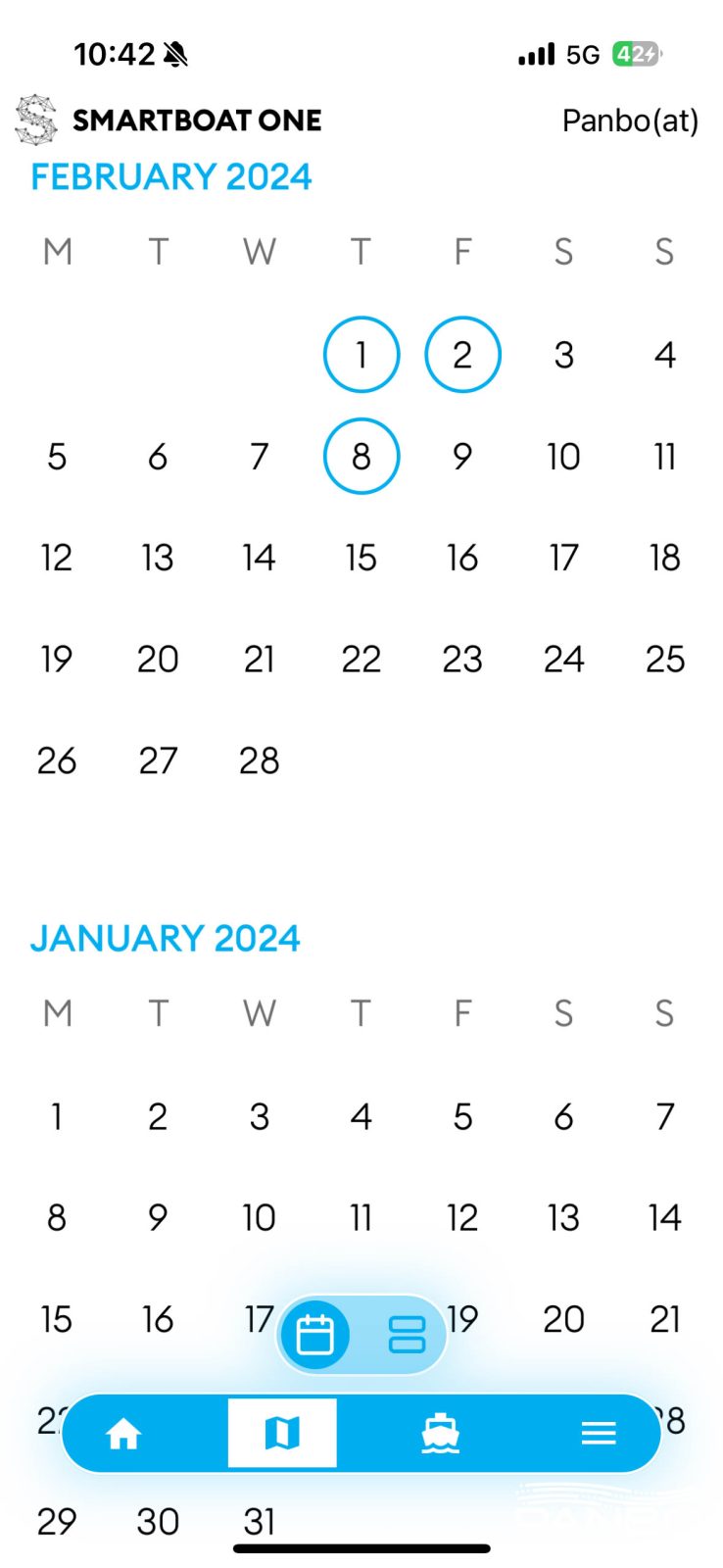
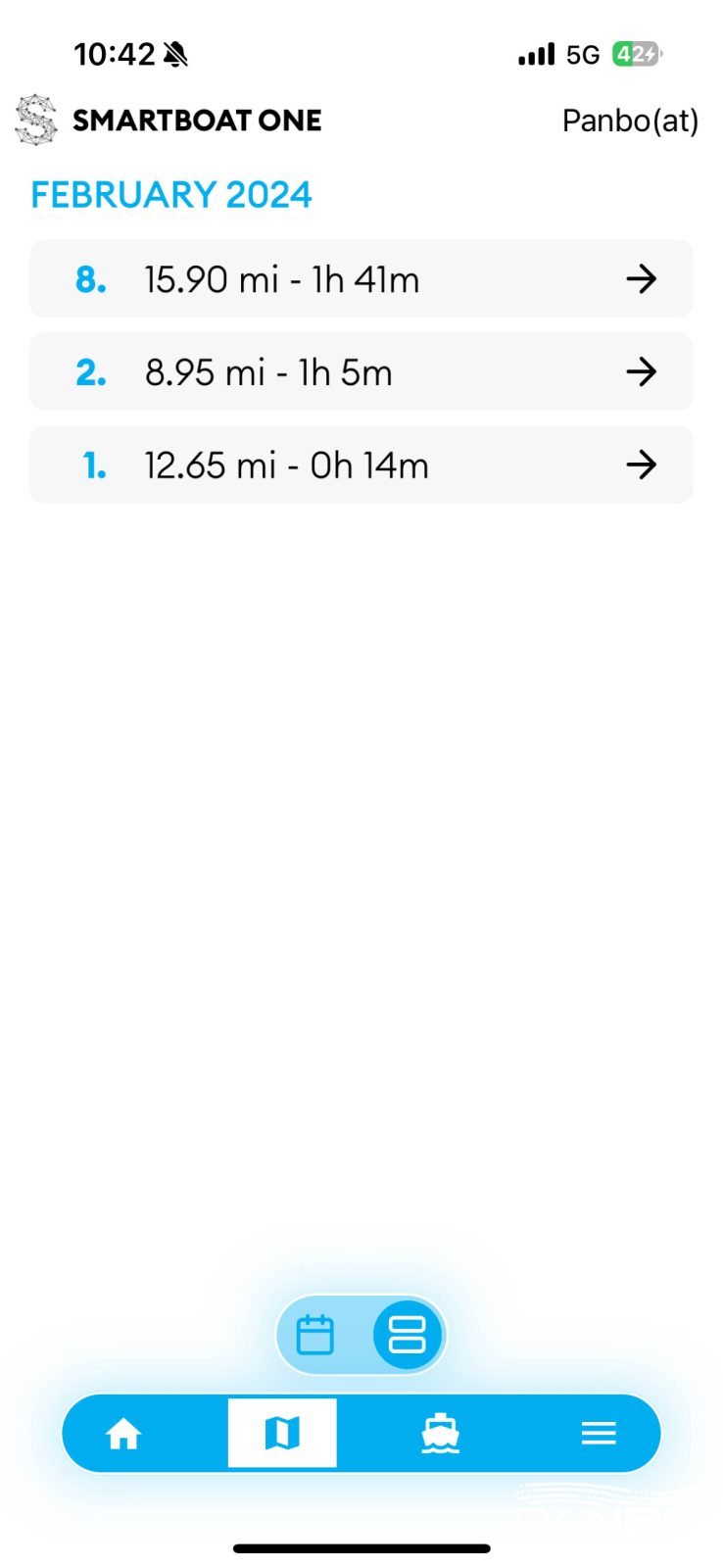
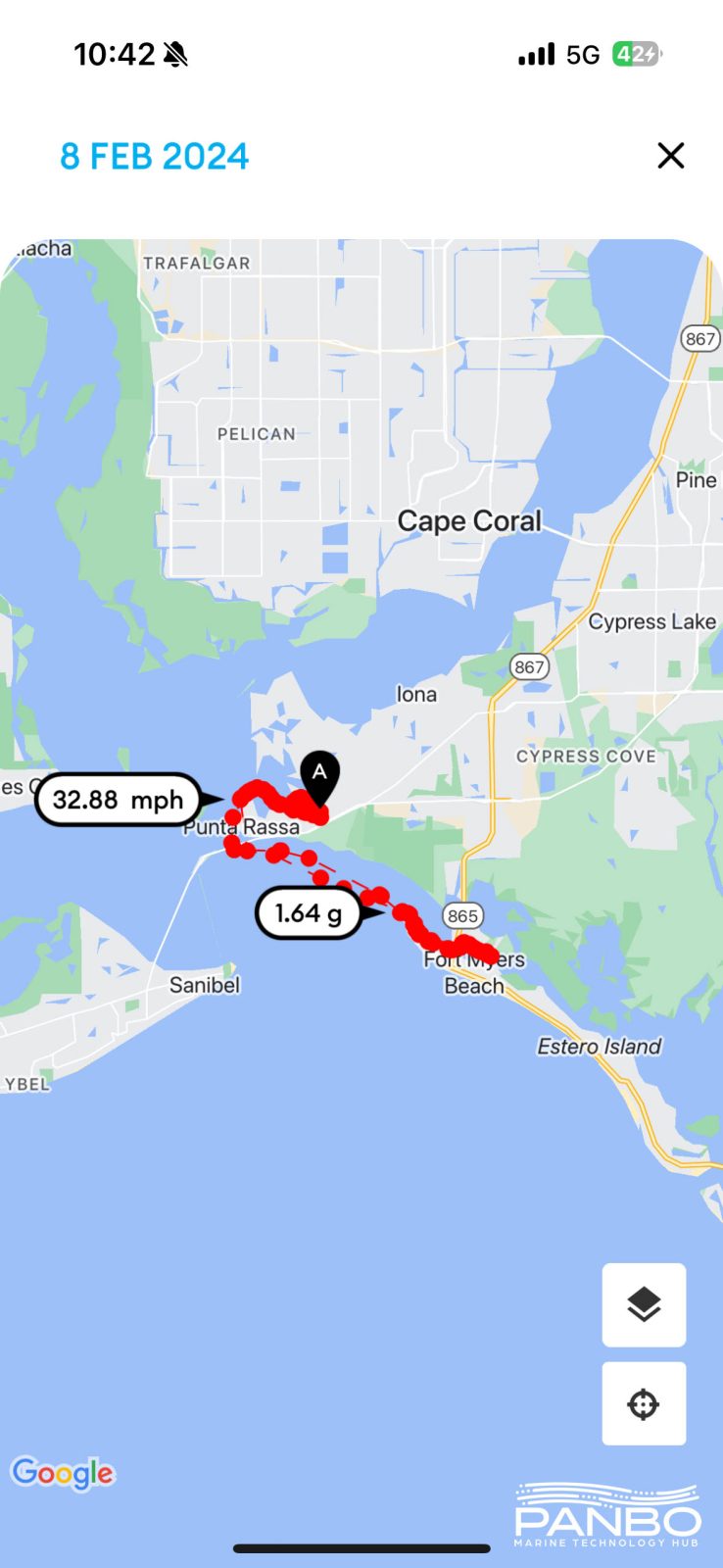
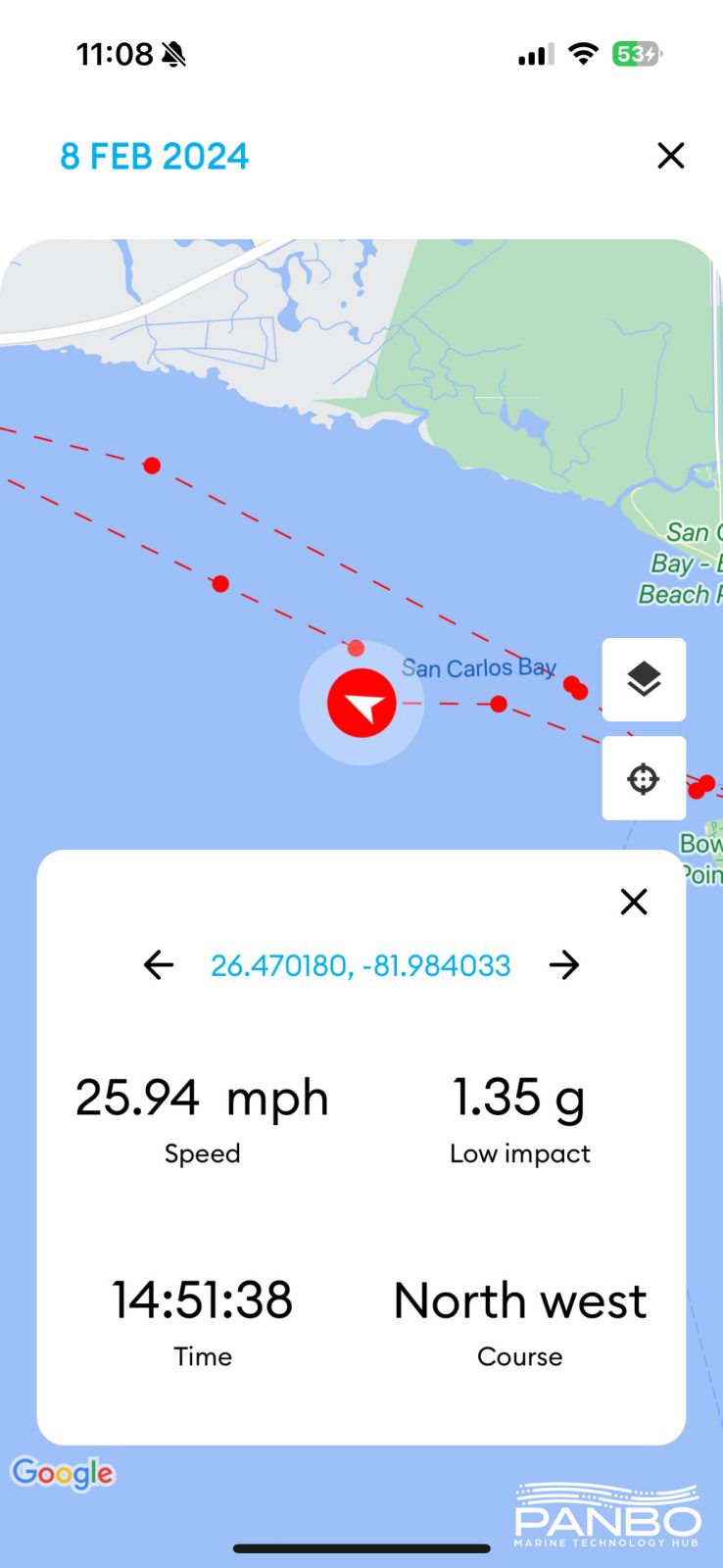
Triplog captures a record of each trip the boat makes. Days with a trip are circled on the calendar. Additionally, you can flip between a calendar view and a list view of your trips. I compared the trip log on my MFD to the one recorded by Sensar and found they matched nearly perfectly for total distance. The zoomed-out view of the trip shows the beginning and ending points as A and B. In the roundtrip log above, A is sitting on top of B. The overview also shows maximum speed and maximum impact as measured in G-forces. Lastly, clicking on an individual point shows the exact position, speed, impact, time, and course.
Geofence
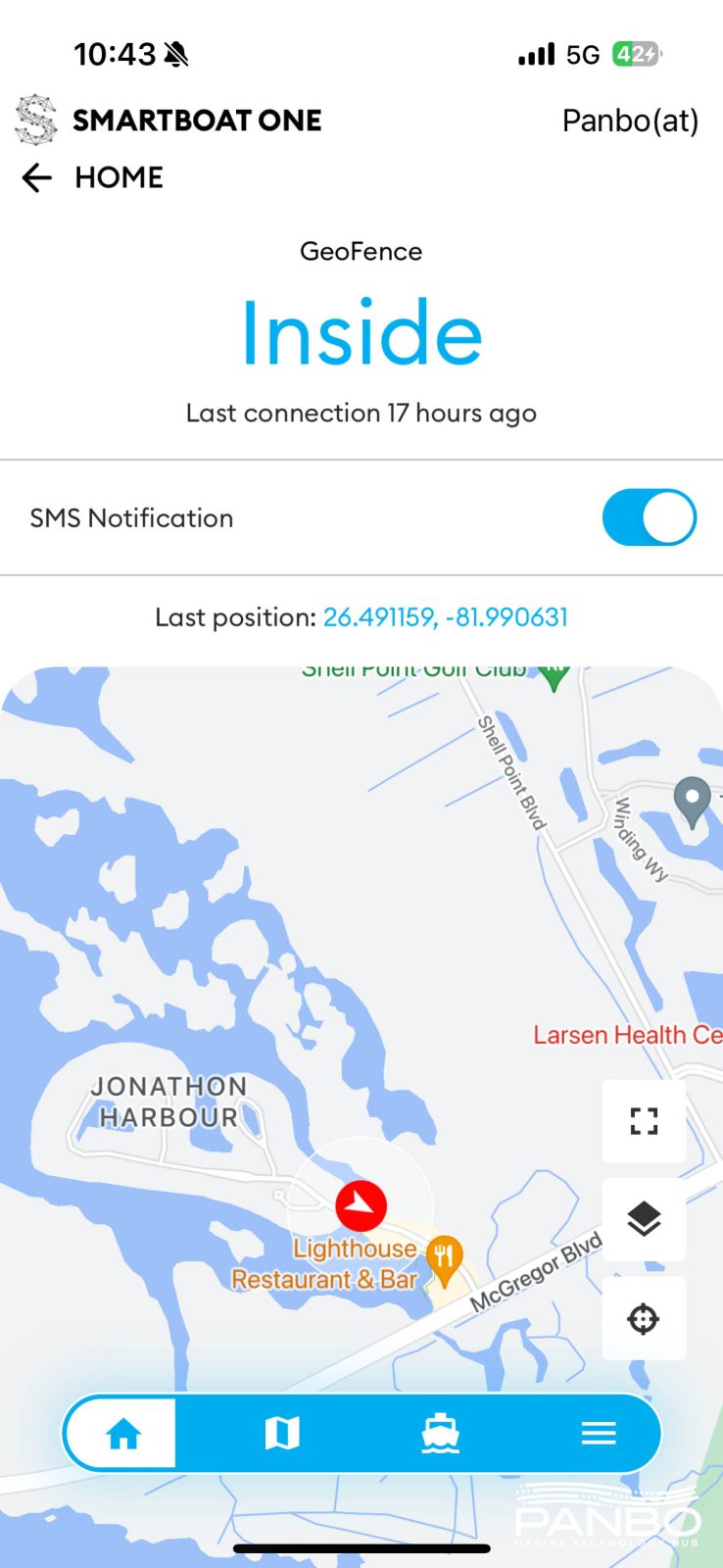
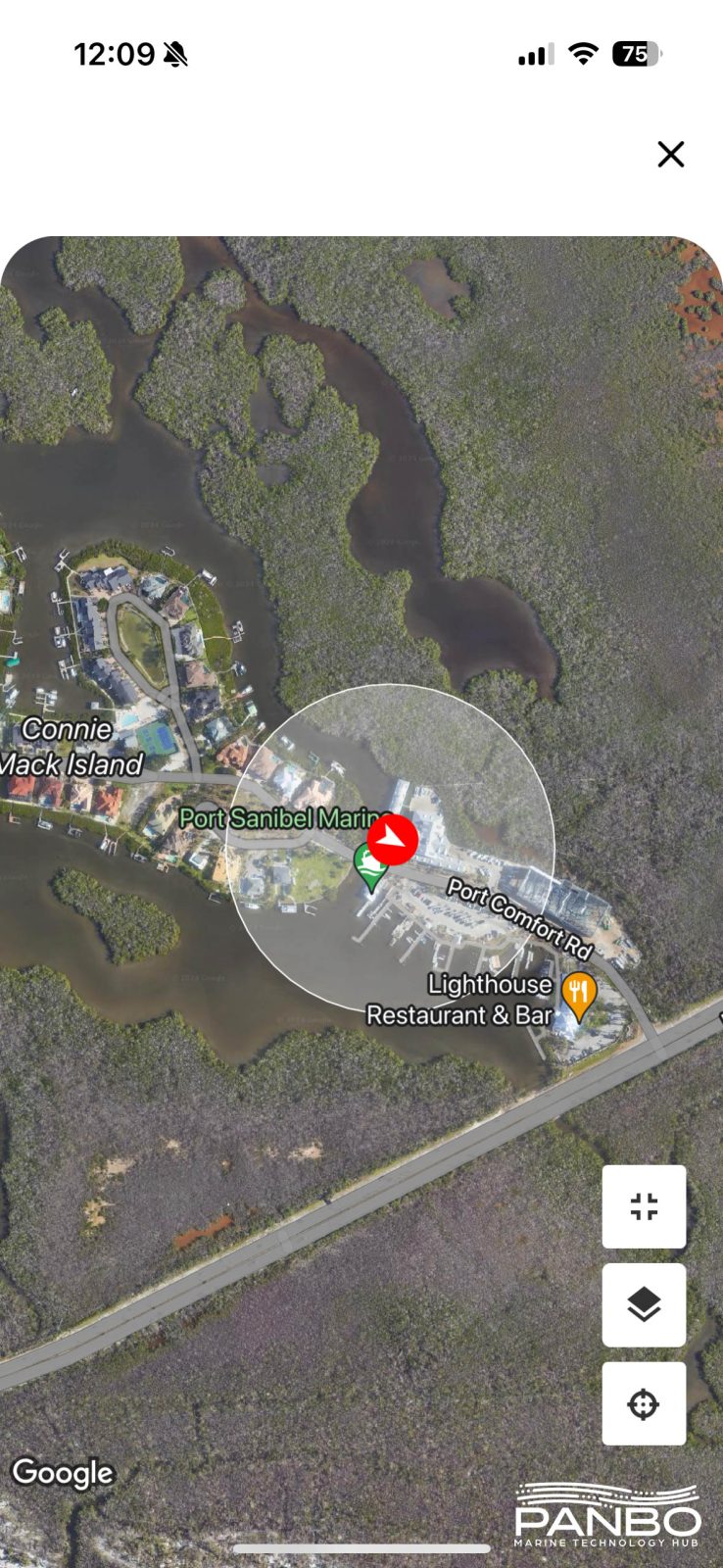
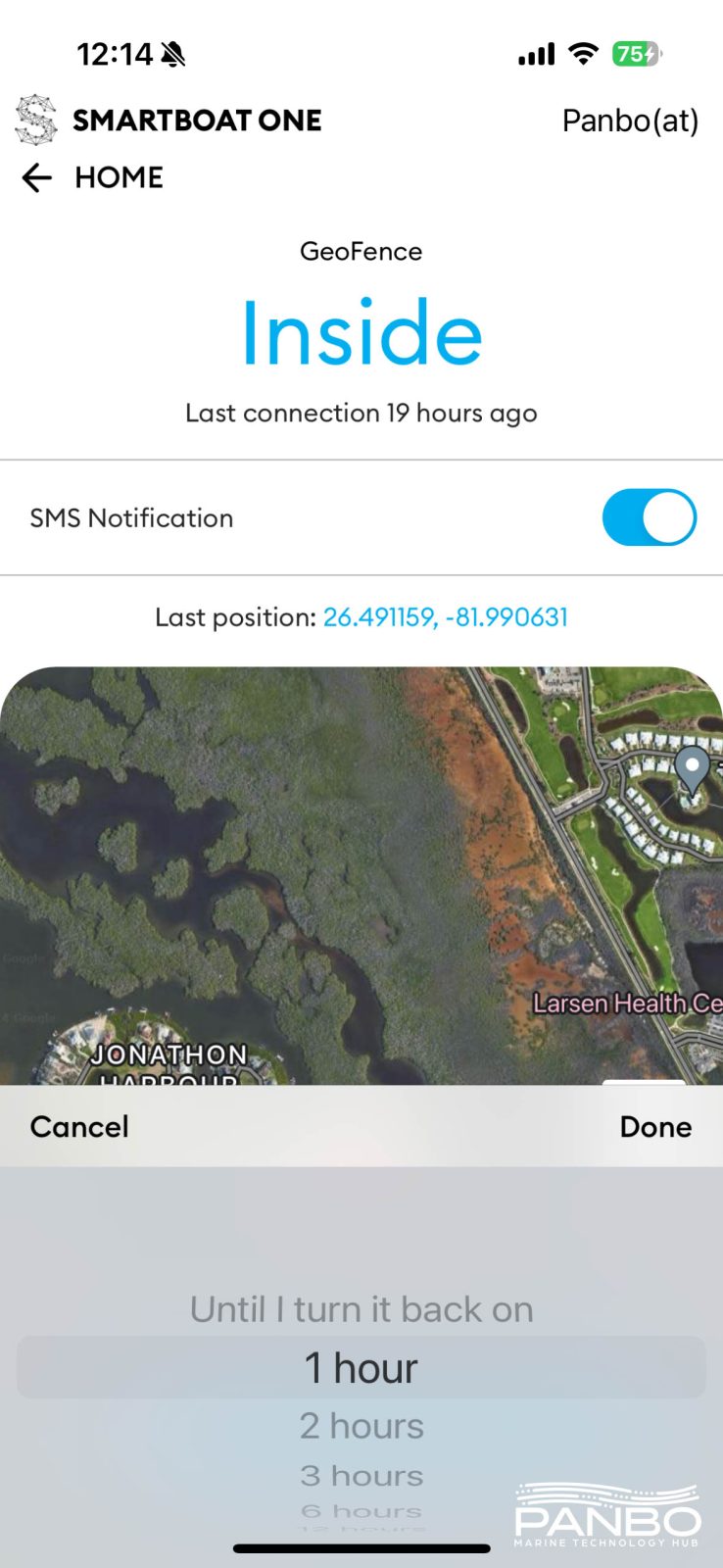
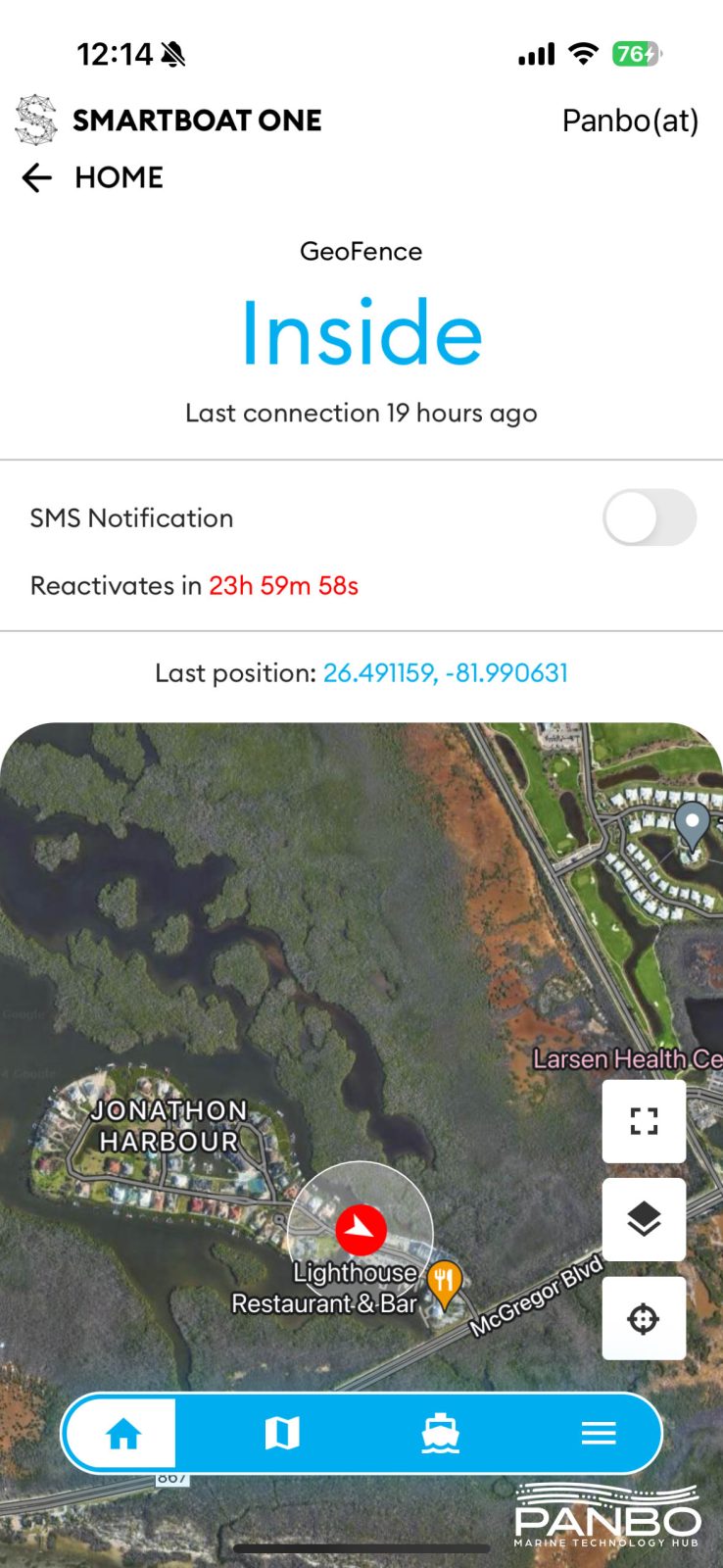
Like other features, geofencing is a hands-off and automatic affair. When a boat dwells in one area long enough, that is determined to be the boat’s home location. The user is then notified if the boat leaves the area. At first, I wasn’t sure about this approach, but the longer I thought about it, the more I got on board. In essence, the system is going to tell you if your boat has been somewhere for a while and then leaves. If that’s expected, you can just ignore it. But, if you got one of those alerts when you weren’t expecting your boat to move, you would sure be appreciative. Additionally, alerts can be suspended for 1-24 hours or indefinitely.
Final thoughts
I’ve discussed a few areas where I would like to see minor tweaks. As I wrote this review I worried that I sounded whiney or negative about a product I really like quite well. All of my quibbles are relatively minor and I think could be easily tweaked. It’s also important to remember that Sensar is aiming this monitor at boats 15 to 35 feet. During my conversations with Sensar’s U.S. rep, he reminded me of their commitment to keep the system simple. I fully recognize the danger of adding just one adjustment here and another there. So, I think they have a challenge to maintain the simplicity of the system while making it as effective as possible for the most boaters.
Let me leave you with this thought. If you own a 15 to 35-foot boat, I think Sensar’s monitor is a great choice for keeping tabs on your boat. Knowing that your batteries are charged, bilge isn’t flooded, bilge pump isn’t running, and the boat is where you left it ensures your boat is safe and ready for use. I thought enough of the monitor that while judging the NMEA’s technology awards, I was one of the judges who awarded Sensar the NMEA’s technology award. At $500 for the system and $10 a month for monitoring, this is one of the most cost-effective systems out there.













Most be developed by some amazing almost god like nation
They should offer a second system, aimed at bigger, more complex boats. I’ve been a Siren Marine user for a long time, and I see things in this that I like a lot. The bilge monitor seems very well thought out, and I like the annual cell phone rate, which Siren Marine just raised. I also like the 30 day history, where SM limits you to a week. BUT I do very much prefer being able to tweak the alarm/alert settings. Give us a more tweakable system, with more data points, for, say, 50% more upfront, but the same low continuing fees, and I’d be very interested.
Hi John, I too am a Siren user and just last week with their app update did I find out you I can pull historical reports from their fleet app site. Really from the beginning of the devices life
Nice review, Ben. Glad you and I agree on the unsuitability of Scothlok connectors (don’t get the other Ben started on this!)
Seems like an OK product, but the deal-killer for me is yet another subscription-based service. I’m sure that’s baked into their business model, but sorry, not interested. As long as I’ve made the investment in hardware and cellular connectivity for my boat, I expect any remote monitoring kits to allow connecting to an existing network as clients…
Doing some research on this system, I think you may be missing the point on the data connection. This system will work for a long period of time with the battery switched OFF. Perfect for a mooring, or a spot with there is no shore power, (trailer for theft etc.). From the research Ive done it’s has the lowest airtime cost and 5 year warranty. If you don’t like the scotch lock wire connectors there are numerous other inexpensive waterproof connectors available. Saw it at New England Boat Show. Looks like a solid system.
Good point Tom, it wasn’t clear to me on the first read that this is targeted to vessels with no power available – as the 40 day battery would suggest. In that scenario, then onboard cellular makes sense, as any existing WiFi network would likely be unpowered as well.
That said, including wireless client capability would likely add little to the cost, and broaden the market to anyone who already has a “connected boat”. But my guess is they’re really committed to the subscription model for revenue…
You baited me, Grant! But let’s be clear that the Scotchlok’s I’ve favored are the ones that include waterproof grease insulation, not the dry splicer discussed above. And the ones I used when installing my EMU-1 are still fine more than a decade later:
https://panbo.com/3m-scotchloks-is-my-love-so-wrong/
Ha! Sorry Ben, couldn’t resist. And yes, I understand all Scotchloks are not created equal. That said, if I’m trying to introduce a new product in the marine industry, he last thing I want to include in the box is something that suggests I don’t understand the environment or accepted industry practices…
Hi Grant, I do agree, but you may not like the reality that hardware manufactures will require subscriptions as long as they are worried about end customer data integrity. These systems are closed not to be difficult but to be secure. The last thing these companies want is for your wifi on your boat to be hacked and now your monitoring system fails to alert you. I would be warry of wifi based or “open” network systems.
Thanks Mike. I’m not an IT expert, but someone hacking into my boat’s WiFi is quite near the bottom of my list of worries. Perhaps if I were a billionaire with a mega-yacht, I’d be more concerned. Pretty sure no one really cares how many times my bilge pump cycles on. Many of the major marine manufacturers products will in fact join an existing network as a client. Anyhow, I’m sure it’s a good fit for some folks. I just don’t need yet another subscription for something I already pay for. Cheers,
I forgot to mention that I like the trip logging this offers. I often forget to start and/or stop that on Navionics, and having it done automatically would be a plus. Siren Marine does not offer a log, really. It will show your track, as long as there’s cell service, but there’s no speed or distance data.
The timing of this couldn’t be better. I’m keeping my boat 80 miles away this season instead of 8, and I can see a lot of peace of mind in having this on board. The fact it has an internal battery is what is most exciting though because I don’t have shore power on my little center console.
So another basic off boat monitoring system is about to release, as I just learned from the Miami Innovation Awards:
https://oversea.boats/
It’s completely self-powered, for years on AA batteries, but I note that its bilge sensor only monitors pump activity, not water level. Also it only has an annual subscription at twice Sensar’s. I look forward to hearing Mr Stein’s take, as he’s actually seen it demonstrated.
I saw the Oversea at MIBS. They were making a lot of claims of performance with AA batteries. Also they have innumerable sensors claiming they reach 1,000 ft. Anyone who has had these systems (I have) knows that wireless sensors come with false alarms and alerts. I’m always weary of companies making too good to be true claims and taking your money before they are available.
I, too, am not a fan of wireless sensors, particularly when it comes to bilge monitoring. The bilge in my Beneteau 411 is very shallow. I had a situation with a low but steady leak after installing a Jet Thruster pump in cockpit compartment. The Siren Marine wireless sensor has a low enough sample rate that it missed a great many pump cycles. I talked to SM about it, and they said some of the low sampling was due to how frequently it could upload to the cloud. They suggested a hard-wired sensor. I hooked that up and suddenly, what looked like a red spike on the chart every hour or so, became a wall of red. I find the battery bank wireless monitors tend to read low, and I’ve talked to other users who’ve experienced the same. Hard-wired remains the most accurate and reliable, as far as I’m concerned.
Wow. That is a complete review. I’ll be much more brief. The Sensar unit recently saved my brand new Ranger Tug R-31. As a boat owner that lives on the coast of Maine but keeps a boat in Seattle (just until I head for Alaska) the monitoring it provides me is amazing. And when BOTH your brand new bilge pumps fail (thanks RULE) and you know you have an immediate issue you can react from 3000 miles away quickly. I’ll say it again Sensar saved my boat. Thank you.
I have had a Sensar Marine installed since they came out a few years ago in Norway. Key takeaways:
– My insurance premium is lowered more than the monthly subscription cost of the system, because I have bilge monitoring, and theft monitoring. Just tell your insurance provider about the system and they will reduce the premium.
– I have saved my batteries from being discharged about 20 times due to me forgetting to turn off the power (hustle with kids and disembarking everyone/everything makes me forget), and the system notifies me via SMS/app-notifications.
– I caught the workshop mechanics joyriding my boat for an “extended” test ride at high G’s and speeds. Could also be used to check that my kids drive the boat responsibly if they borrow it someday.
And most importantly, I live 3 hours away from my boat, and it’s nice to know how it’s doing. If SM alerts me to an issue I can call a friend who lives closer and check on it.